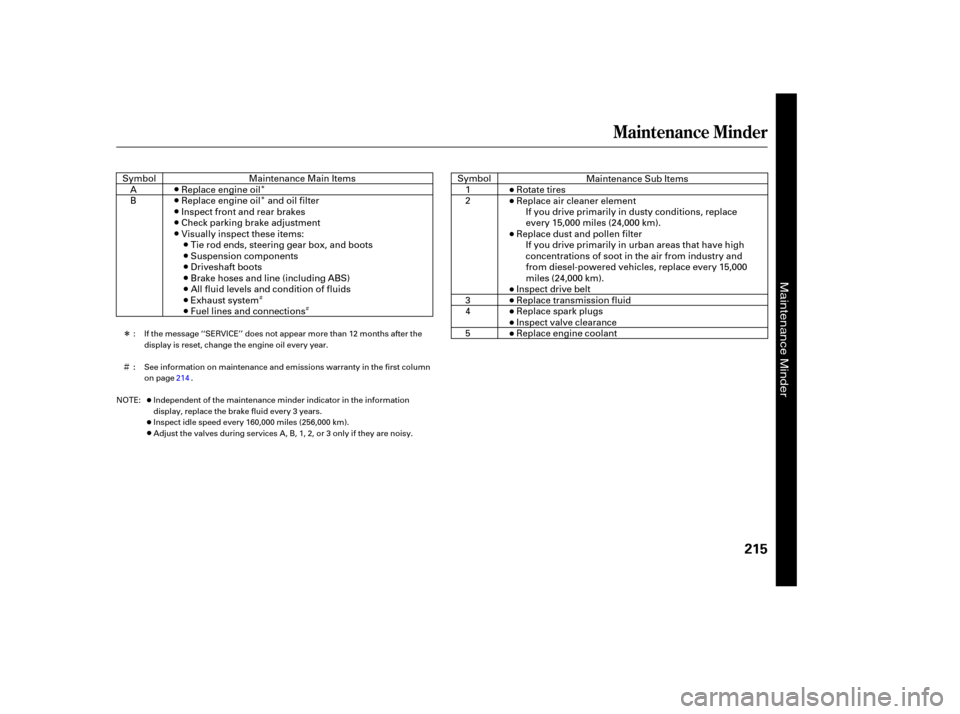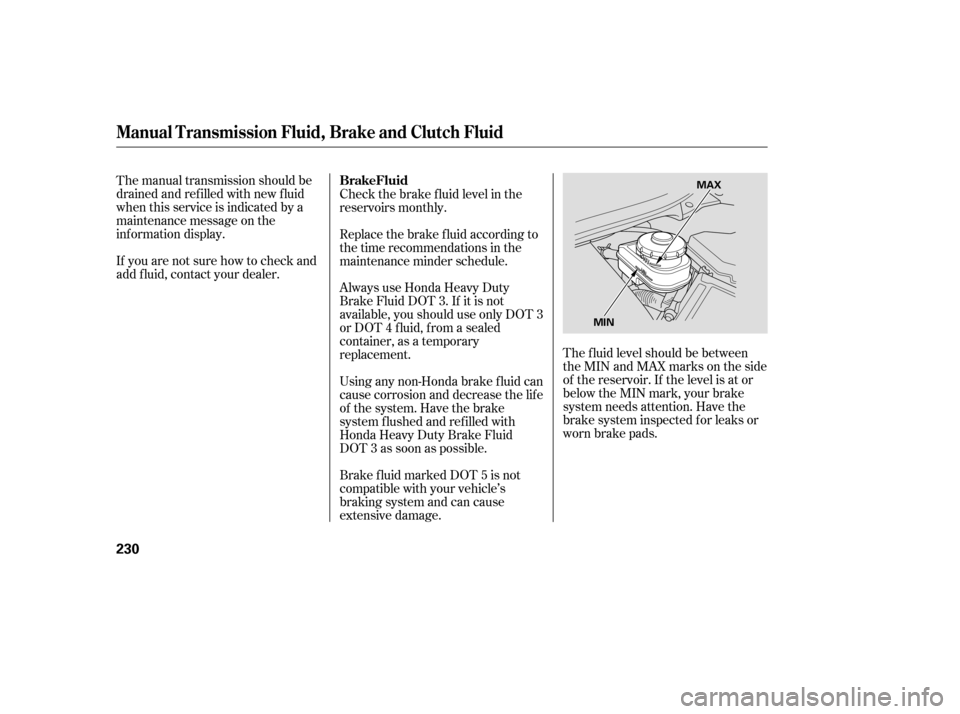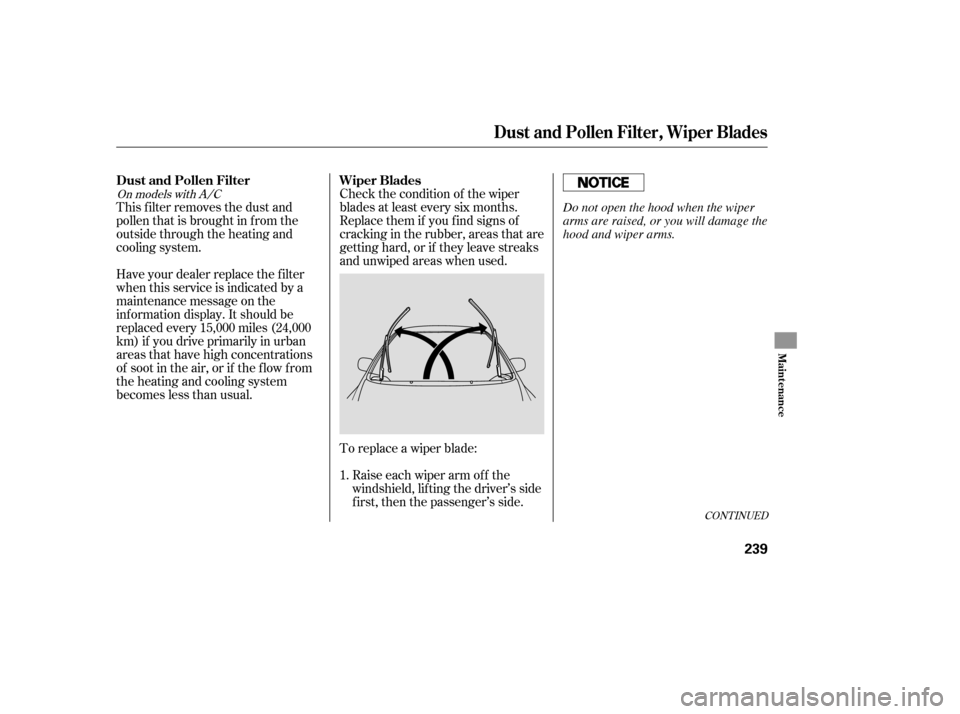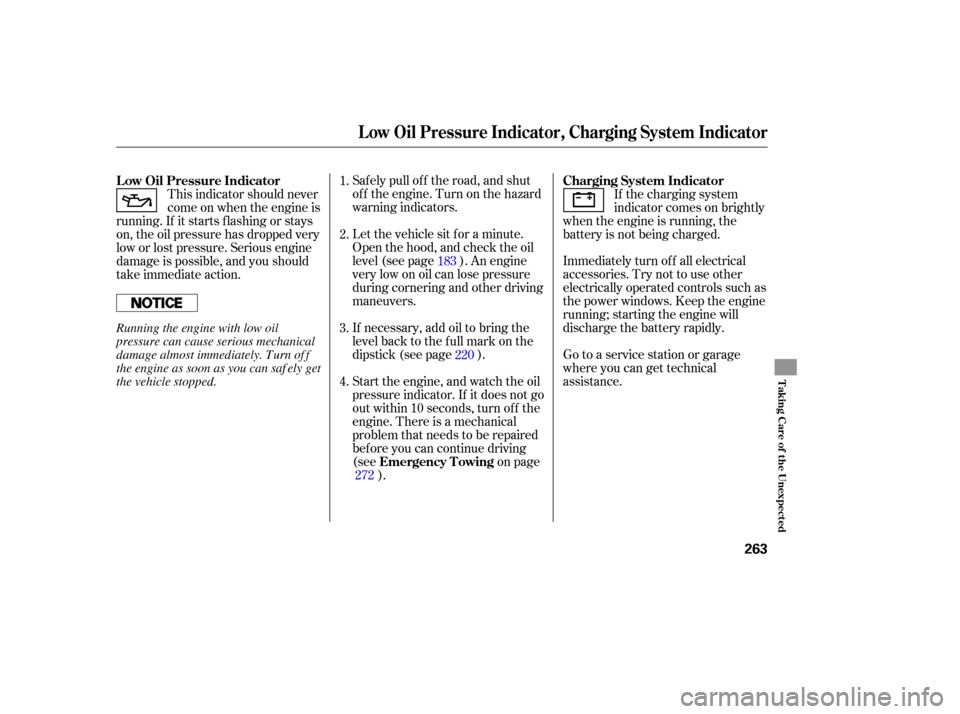Page 219 of 307

�Î
�Î
�Ì �Ì
�Ì �Î
Maintenance Minder
215
:If the message ‘‘SERVICE’’ does not appear more than 12 months after the
display is reset, change the engine oil every year.
See information on maintenance and emissions warranty in the first column
on page .
Independent of the maintenance minder indicator in the information
display, replace the brake fluid every 3 years.
Inspect idle speed every 160,000 miles (256,000 km).
Adjust the valves during services A, B, 1, 2, or 3 only if they are noisy.
NOTE: :
214
Maintenance Sub Items
Rotate tires
Replace air cleaner element If you drive primarily in dusty conditions, replace
every 15,000 miles (24,000 km).
Replace dust and pollen filter If you drive primarily in urban areas that have high
concentrations of soot in the air from industry and
from diesel-powered vehicles, replace every 15,000
miles (24,000 km).
Inspect drive belt
Replace transmission fluid
Replace spark plugs
Inspect valve clearance
Replace engine coolant
Maintenance Main Items
Replace engine oil
Replace engine oil and oil filter
Inspect front and rear brakes
Check parking brake adjustment
Visually inspect these items: Tie rod ends, steering gear box, and boots
Suspension components
Driveshaft boots
Brake hoses and line (including ABS)
All fluid levels and condition of fluids
Exhaust system
Fuel lines and connections
A
B
Symbol
Symbol
1
2
3
4
5
Maintenance Minder
�����—�����—�����y�
�������������y���
�(�+���������y�����
���y
Page 220 of 307
Maintenance Record
216
mi
mi
mi
mi
mi
mi
mimi
mi
mi
mi
mi
mi
mi
Maintenance
Performed
AB12345
AB12345
AB12345
AB12345
AB12345
AB12345
AB12345 Signature
Date
Maintenance
Performed
AB12345
AB12345
AB12345
AB12345
AB12345
AB12345
AB12345Signature
Date
Mileage
km
km
km
km
km
km
km Mileage
km
km
km
km
km
km
km
You or the servicing dealer can record all completed maintenance here. When maintenance is performed, record the mileage, circle the coded item(s)
completed, and write in any other non-coded items (such as brake fluid replacement) below the codes. Keep the receipts for all work done on your
vehicle. Maintenance can also be recorded in your Honda service history booklet.
�����—�����—�����y�
�������������y���
�(�+���������y�����
���y
Page 226 of 307
Open the hood, and remove the
engine oil f ill cap. Remove the oil
drain bolt and washer f rom the
bottom of the engine. Drain the oil
into an appropriate container.
Always change the oil and f ilter
according to the maintenance
messages shown on the inf ormation
display. The oil and f ilter collect
contaminants that can damage your
engine if they are not removed
regularly.
Changing the oil and f ilter requires
special tools and access f rom
underneath the vehicle. The vehicle
should be raised on a service station-
type hydraulic lif t f or this service.
Unless you have the knowledge and
proper equipment, you should have
this maintenance done by a skilled
mechanic.
Run the engine until it reaches
normal operating temperature,
then shut it off.
1. 2.
Changing the Oil and Filter
222
DRAIN BOLT
WASHER
DRAIN BOLT
WASHER
Si
DX, Canadian DX-G, LX, EX
�����—�����—�����y�
�������������y���
�(�+���������y���������y
Page 233 of 307

If Honda MTF is not available, you
may use an SAE 10W-30 or 10W-40
viscosity motor oil with the API
Certif ication seal that says ‘‘FOR
GASOLINE ENGINES’’ as a
temporary replacement. However,
motor oil does not contain the proper
additives, and continued use can
cause stif f er shif ting. Replace as
soon as it is convenient.
Check the f luid level with the
transmission at normal operating
temperature and the vehicle sitting
on level ground. Remove the
transmission f iller bolt, and caref ully
f eel inside the bolt hole with your
f inger. The f luid level should be up
to the edge of the bolt hole. If it is
not, add Honda Manual
Transmission Fluid (MTF) until it
starts to run out of the hole. Reinstall
the f iller bolt, and tighten it securely.
Insert the dipstick all the way back
into the transmission securely as
shown in the illustration.
The automatic transmission should
be drained and ref illed with new f luid
when this service is indicated by a
maintenance message on the
inf ormation display.
If you are not sure how to add f luid,
contact your dealer. 6.
CONT INUED
Manual Transmission Fluid
A utomatic T ransmission Fluid, Manual T ransmission Fluid
Maint enance
229
FILLER BOLT
Correct LevelSiFILLER BOLT
Correct Level
DX, Canadian DX-G, LX, EX
�����—�����—�����y�
�������������y���
�(�+���������y���������y
Page 234 of 307

The f luid level should be between
theMINandMAXmarksontheside
of the reservoir. If the level is at or
below the MIN mark, your brake
system needs attention. Have the
brake system inspected f or leaks or
worn brake pads.
T
he
manual transmission should be
drained and ref illed with new f luid
when this service is indicated by a
maintenance message on the
inf ormation display.
If you are not sure how to check and
add f luid, contact your dealer.
Brake f luid marked DOT 5 is not
compatible with your vehicle’s
braking system and can cause
extensive damage. Using any non-Honda brake f luid can
cause corrosion and decrease the lif e
of the system. Have the brake
system f lushed and ref illed with
Honda Heavy Duty Brake Fluid
DOT 3 as soon as possible. Always use Honda Heavy Duty
Brake Fluid DOT 3. If it is not
available, you should use only DOT 3
or DOT 4 f luid, f rom a sealed
container, as a temporary
replacement. Replace the brake f luid according to
thetimerecommendationsinthe
maintenance minder schedule. Check the brake f luid level in the
reservoirs monthly.
Manual Transmission Fluid, Brake and Clutch Fluid
230
MAX
MIN
�����—�����—�����y�
�����������
�y���
�(�+���������y���������y
Brake Fluid
Page 243 of 307

Check the condition of the wiper
blades at least every six months.
Replace them if you f ind signs of
cracking in the rubber, areas that are
getting hard, or if they leave streaks
and unwiped areas when used.
This f ilter removes the dust and
pollenthatisbroughtinfromthe
outside through the heating and
cooling system.
To replace a wiper blade:
Have your dealer replace the filter
when this service is indicated by a
maintenance message on the
inf ormation display. It should be
replaced every 15,000 miles (24,000
km) if you drive primarily in urban
areas that have high concentrations
of soot in the air, or if the f low f rom
the heating and cooling system
becomeslessthanusual.
Raise each wiper arm of f the
windshield, lif ting the driver’s side
first, then the passenger’s side.
1.
CONT INUED
On models with A/C
Wiper Blades
Dust and Pollen Filter
Dust and Pollen Filter, Wiper Blades
Maint enance
239
Do not open the hood when the wiper
arms are raised, or you will damage the
hood and wiper arms.
�����—�����—�����y�
����
��������y���
�(�+���������y���������y
Page 260 of 307
Remove the center cap from the
flat tire.Place the flat tire face down in the
spare tire well.
Remove the spacer cone f rom the
wing bolt, turn it over, and put it
back on the bolt.
Secure the f lat tire by screwing
the wing bolt back into its hole.
Tighten the wheel nuts securely in
the same crisscross pattern. Have
the wheel nut torque checked at
the nearest automotive service
f acility.
Tighten the wheel nuts to:
14.
15.
13.
16.
17.
Changing a Flat Tire
256
WING BOLT
SPACER CONE
For
compact
spare tireFor normal
tire
80 lbf·ft (108 N·m , 11 kgf·m)
�����—�����—�����y�
����
��������y���
�(�+���������y���������y
OnEXandSimodelsintheU.S.,and
LX, EX, andSi models in Canada
Page 267 of 307

Saf ely pull of f the road, and shut
of f the engine. Turn on the hazard
warning indicators.
If necessary, add oil to bring the
level back to the full mark on the
dipstick (see page ).Immediately turn of f all electrical
accessories. Try not to use other
electrically operated controls such as
the power windows. Keep the engine
running; starting the engine will
discharge the battery rapidly.
Go to a service station or garage
where you can get technical
assistance.
Let the vehicle sit f or a minute.
Open the hood, and check the oil
level (see page ). An engine
very low on oil can lose pressure
during cornering and other driving
maneuvers.
If the charging system
indicator comes on brightly
when the engine is running, the
battery is not being charged.
This indicator should never
come on when the engine is
running. If it starts f lashing or stays
on, the oil pressure has dropped very
low or lost pressure. Serious engine
damage is possible, and you should
take immediate action.
Start the engine, and watch the oil
pressure indicator. If it does not go
out within 10 seconds, turn of f the
engine. There is a mechanical
problem that needs to be repaired
bef ore you can continue driving
(see on page).
1.
2.
3.
4.
183
220
272 Charging System Indicator
L ow Oil Pressure Indicator
Emergency T owing
L ow Oil Pressure Indicator, Charging System Indicator
T aking Care of t he Unexpect ed
263
Running the engine with low oil
pressure can cause serious mechanical
damage almost immediately. Turn of f
the engine as soon as you can saf ely get
the vehicle stopped.
�����—�����—�����y�
����
��������y���
�(�+���������y���������y